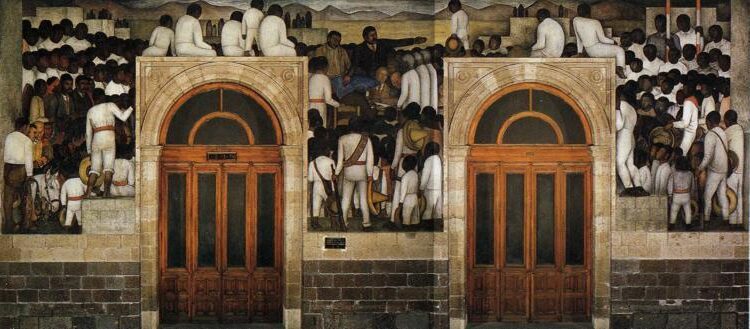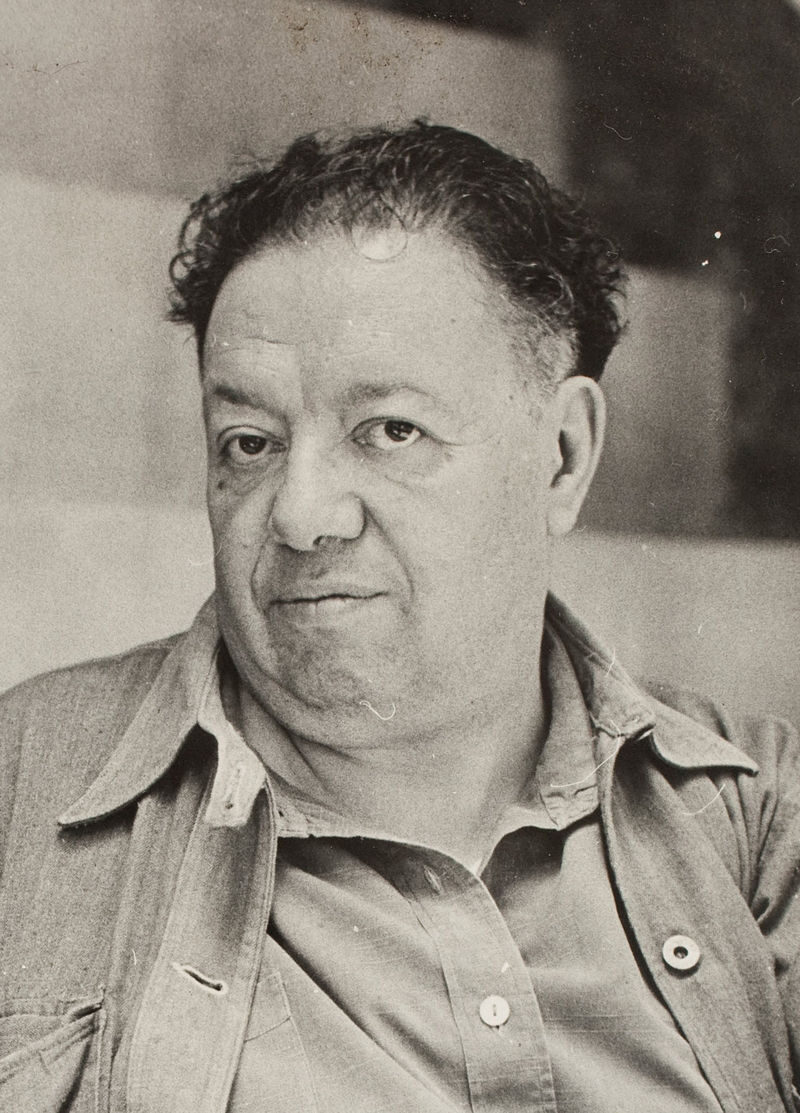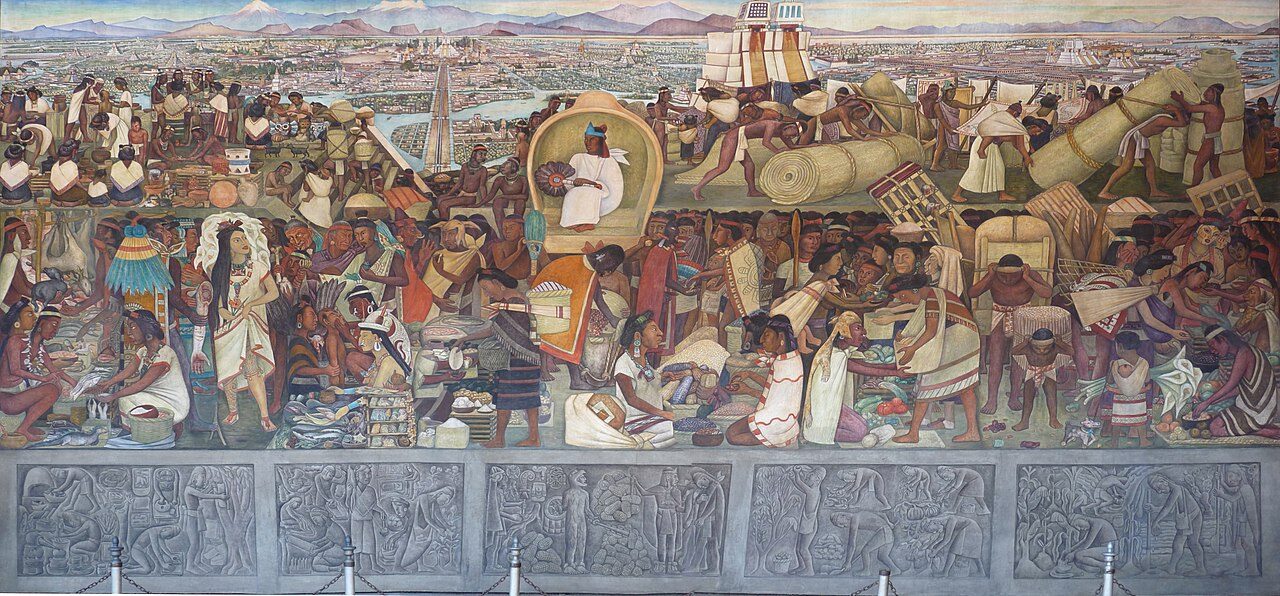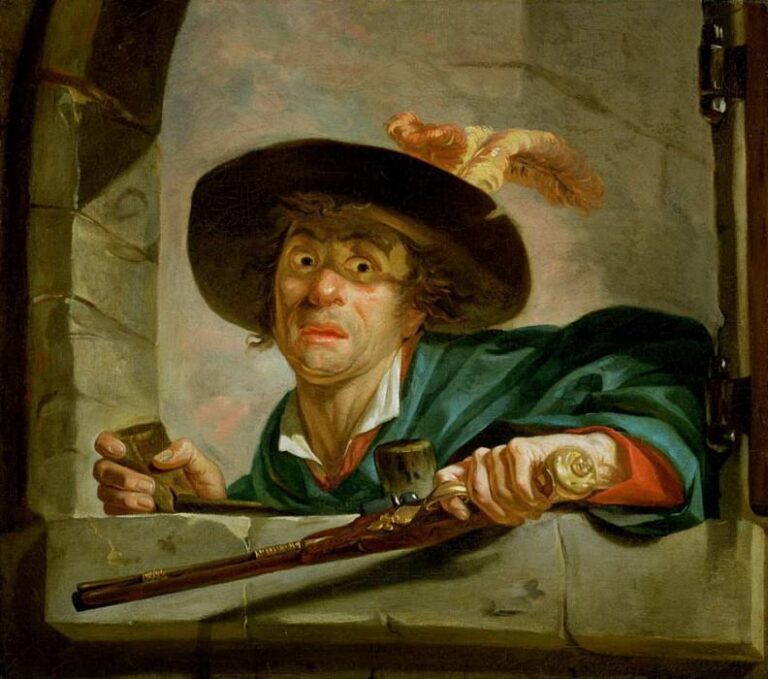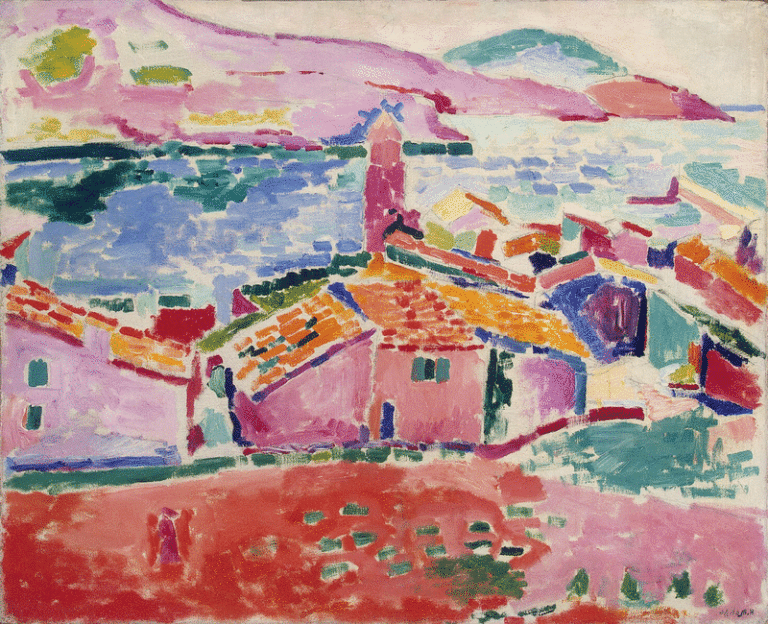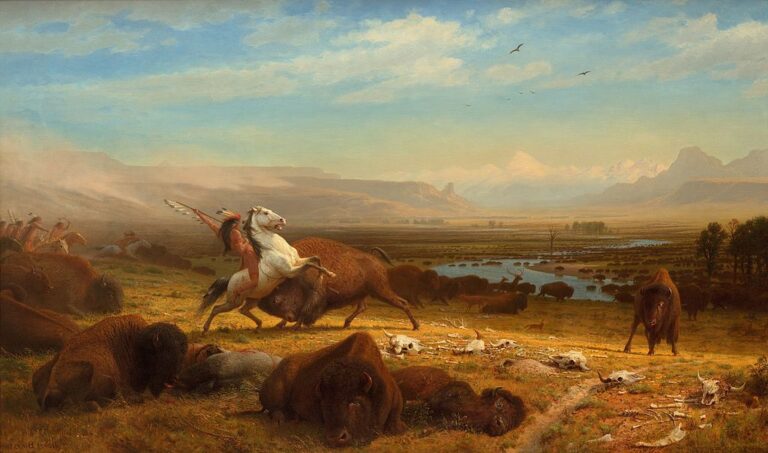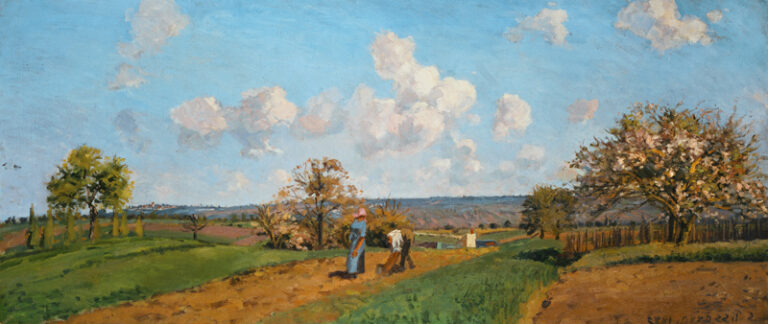Diego Rivera Painter: Life and Legacy of Mexico’s Revolutionary Muralist
Born: December 8, 1886, Guanajuato City, Mexico
Death: November 24, 1957, Mexico City, Mexico
Art Movement: Cubism, Realism, Mexican Muralism
Nationality: Mexican
Influenced By: Paul Cézanne
Institution: Academy of San Carlos, Mexico
Diego Rivera Painter: Life and Legacy of Mexico’s Revolutionary Muralist
Early Life and Education of Diego Rivera
Diego Rivera‘s journey to becoming one of Mexico’s most celebrated artists began in his childhood and was shaped by his formal education in both Mexico and Europe. His early experiences and training significantly influenced his distinctive artistic style and political perspective.
Childhood in Guanajuato
Diego Rivera was born on December 8, 1886, in Guanajuato, Mexico. He had a twin brother who died in infancy. From an early age, Rivera showed remarkable artistic talent.

The Blood of the Revolutionary Martyrs Fertilizing the Earth, 1926–1927
At just three years old, he began drawing on the walls of his home. His parents, rather than punishing this behavior, encouraged his creativity by installing chalkboards and canvas on the walls.
The family moved to Mexico City when Diego was six years old. There, he enrolled in the San Carlos Academy of Fine Arts at age ten, much younger than most students. His early works demonstrated exceptional skill in traditional techniques.
Artistic Training in Europe
In 1907, Rivera received a scholarship to study in Europe. He arrived in Spain where he studied under Eduardo Chicharro, a respected Spanish painter.
Rivera spent nearly 14 years in Europe, primarily in Paris, where he absorbed the revolutionary artistic movements of the time. He studied traditional techniques at the Academy of San Fernando in Madrid.
His European period was vital to his development. Rivera met and worked alongside notable artists including Pablo Picasso and Georges Braque. These relationships exposed him to new ideas about form, color, and composition that would later influence his own distinctive style.
Influences of Cubism and Post-Impressionism
Rivera experimented extensively with Cubism between 1913 and 1917. During this period, he produced nearly 200 Cubist paintings, showing his mastery of the fragmented, geometric style.
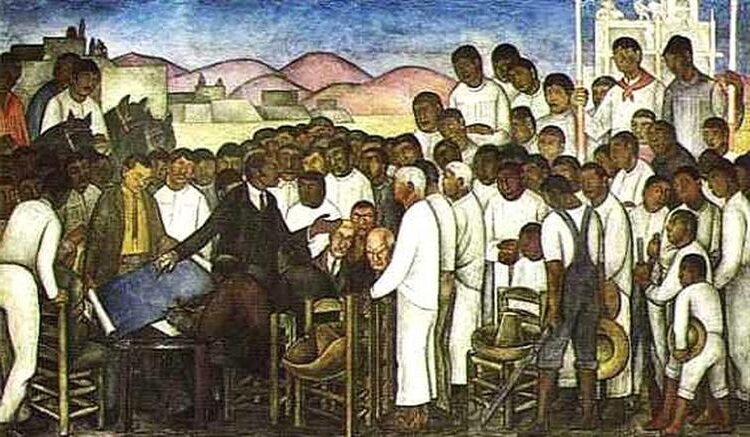
Partition of the Land, 1924 by Diego Rivera
The colors and techniques of Post-Impressionism also influenced his work. Rivera was particularly drawn to Paul Cézanne’s approach to structure and form.
Despite embracing European modernism, Rivera never lost connection to his Mexican roots. In 1921, he traveled to Italy to study Renaissance frescos, which would later inspire his famous murals.
These diverse influences—European modernism, traditional techniques, and his Mexican heritage—combined to form Rivera’s unique artistic voice that would soon revolutionize Mexican art through monumental public murals.
Artistic Contributions and Major Works
Diego Rivera transformed the art world with his large-scale murals and distinctive painting style. His work brought Mexican history and culture to life while addressing social and political issues of his time.
Creation of Murals and Their Significance
Rivera pioneered the Mexican Muralism movement in the 1920s. This revolutionary art form made fine art accessible to all people, not just the wealthy who could afford private collections.
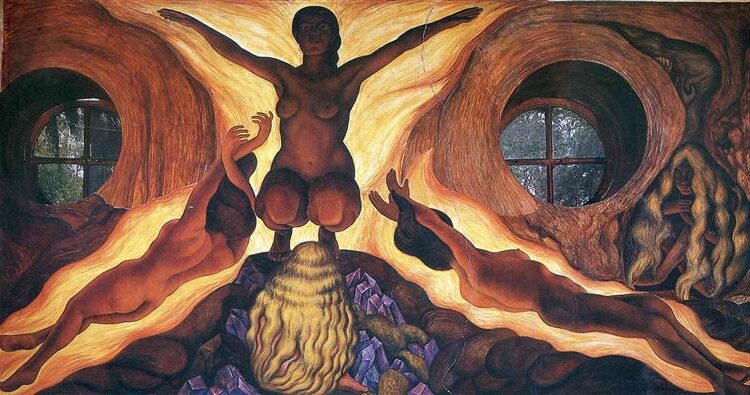
Subterranean Forces, 1926–1927 by Diego Rivera
His murals served as visual history lessons for a largely illiterate population. They celebrated indigenous cultures and workers while criticizing exploitation and inequality.
Rivera developed a unique technique for his frescoes. He painted directly on wet plaster, requiring quick work and no room for mistakes. This ancient method, which he modernized, created vibrant colors that became his trademark.
The social impact of Rivera’s murals cannot be overstated. They helped forge a sense of national identity in post-revolutionary Mexico and influenced generations of artists worldwide.
Notable Projects in Mexico
The Ministry of Education in Mexico City houses Rivera’s first major mural project (1923-1928). It consists of 124 fresco panels depicting Mexican society, history, and traditions across three floors.

Man, Controller of the Universe, 1934 (Recreation of Man at the Crossroads)
Significant Mexican Works:
- National Palace murals (1929-1935): Epic portrayal of Mexican history
- Chapingo Agricultural School (1926-1927): Celebration of agriculture and earth
- Palacio de Bellas Artes (1934-1935): “Man at the Crossroads” recreation
- Hospital de la Raza (1953): “The People’s Demand for Better Health”
Rivera’s “Dream of a Sunday Afternoon in Alameda Park” (1947) is particularly notable. This 15-meter mural features over 400 figures from Mexican history, including Rivera himself as a child.
Works in the United States
Rivera created several controversial murals in the United States during the 1930s. His Detroit Industry murals (1932-1933) at the Detroit Institute of Arts celebrate industrial workers and modern manufacturing.
In San Francisco, Rivera painted “Pan American Unity” (1940), a massive work showing cooperation between North and South America. The mural now resides at City College of San Francisco.
Rivera’s most infamous U.S. project was for Rockefeller Center. The mural “Man at the Crossroads” (1933) was destroyed before completion because it included an image of Vladimir Lenin. This controversy highlighted the political tensions in Rivera’s work.
His marriage to Frida Kahlo brought him additional attention in American art circles. Together they influenced numerous artists and collectors in the United States.
Themes and Styles Explored
Rivera’s artistic style blended elements of European modernism with Mexican folk traditions. His use of bold colors, simplified forms, and monumental scale created a distinctive visual language.
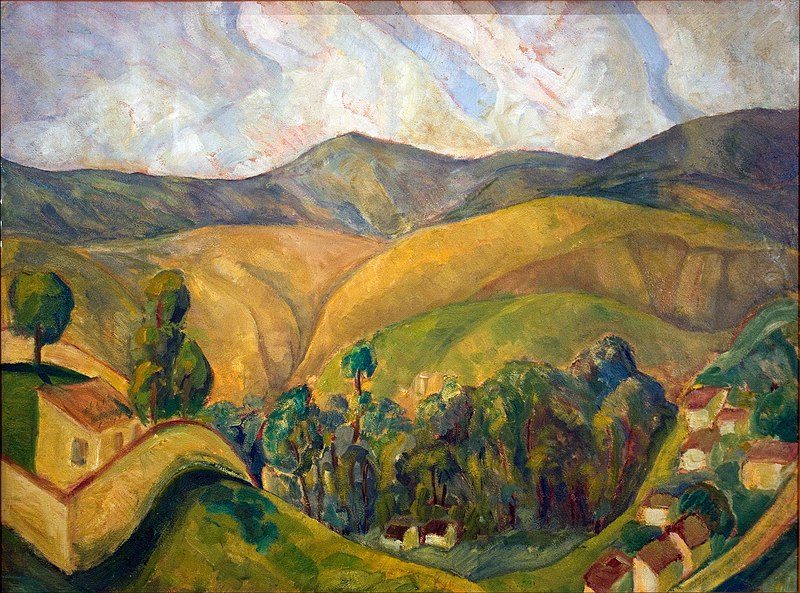
Landscape, 1911 by Diego Rivera
Key themes in Rivera’s work:
- Indigenous Mexican history and culture
- Working-class struggle and labor movements
- Revolutionary politics and anti-capitalism
- Agricultural traditions and connection to the land
Rivera incorporated Cubist techniques learned in Europe but rejected pure abstraction. He believed art should be accessible and meaningful to ordinary people.
His figures often appeared flattened and stylized, with exaggerated proportions that emphasized their strength and dignity. This approach helped elevate everyday workers to heroic status in his compositions.
Despite his focus on social themes, Rivera also created beautiful still lifes and portraits that showcased his technical skill and versatility.
Personal Life and Relationships
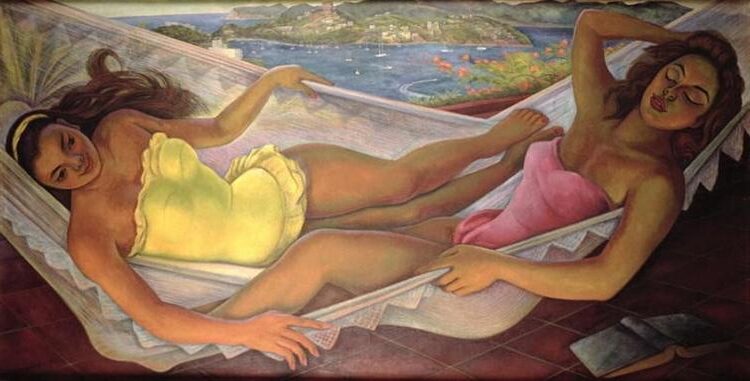
The Hammock, 1956 by Diego Rivera
Diego Rivera’s personal life was as colorful and complex as his murals. His relationships and political beliefs strongly influenced his artistic work and public persona throughout his lifetime.
Marriage to Frida Kahlo
Rivera’s most famous relationship was with fellow artist Frida Kahlo. They married twice—first in 1929, then again in 1940 after a brief divorce. Their tumultuous relationship was marked by mutual infidelity and passionate reconciliations.
The couple lived in Rivera’s studio home, known as the Blue House, in Coyoacán, Mexico City. Despite their troubles, they shared deep intellectual and artistic connections that inspired each other’s work.
Both artists suffered health problems. Rivera’s obesity contributed to heart issues, while Kahlo endured lifelong pain from a bus accident. Despite these challenges, they remained important figures in each other’s lives until Kahlo’s death in 1954.
Rivera had three children from previous relationships but none with Kahlo, who suffered several miscarriages.
Political Affiliations and Ideology
Rivera was a dedicated Communist for most of his adult life. He joined the Mexican Communist Party in 1922 and remained committed to Marxist ideals throughout his career.
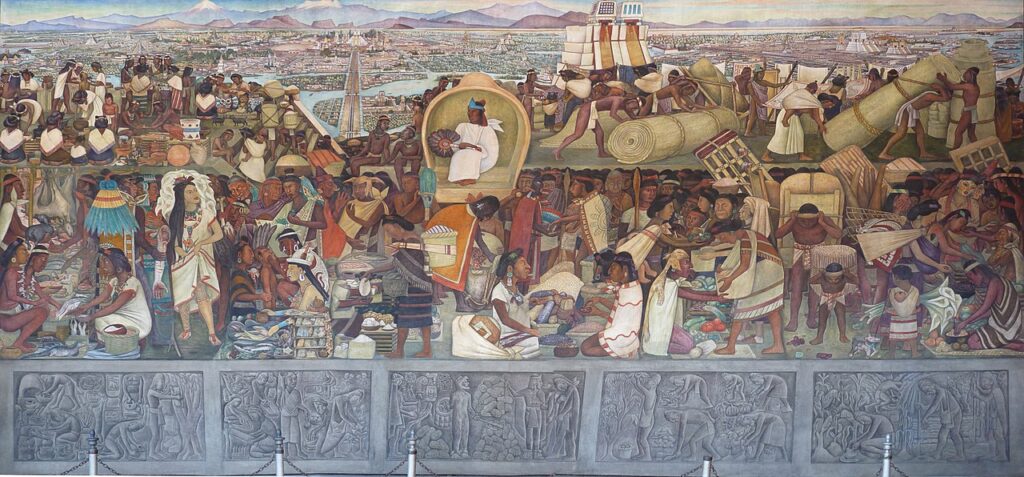
Mural of the Aztec Market of Tlatelolco by Diego Rivera
His political beliefs heavily influenced his murals, which often depicted workers’ struggles and revolutionary themes. In 1927, Rivera visited the Soviet Union, strengthening his communist convictions.
However, his relationship with the party was complicated. In 1929, he was expelled for accepting commissions from the Mexican government and American capitalists. Rivera later provided asylum to exiled Soviet revolutionary Leon Trotsky in his home.
Despite controversies, including the destruction of his Rockefeller Center mural for including an image of Lenin, Rivera never abandoned his leftist principles. His art consistently championed the working class and indigenous peoples of Mexico.
Frequently Asked Questions
Diego Rivera’s work sparked many discussions about art, politics, and Mexican identity. His distinctive style and bold subject choices made him one of the most influential artists of the 20th century.
What is Diego Rivera known for in the art community?
Diego Rivera is renowned for his large-scale murals that blend social commentary with historical narratives. He developed a distinctive style featuring simplified figures with bold outlines and vibrant colors.
His work revived fresco painting techniques and brought them into modern contexts. Rivera’s art made complex social and political ideas accessible to the public through visual storytelling.
He gained international recognition for integrating indigenous Mexican art forms with European painting traditions. This fusion created a unique aesthetic that celebrated Mexican heritage while engaging with contemporary art movements.
How did Diego Rivera’s mural works contribute to Mexican culture and heritage?
Rivera’s murals documented Mexico’s history from pre-Columbian civilizations through the Mexican Revolution. These works helped establish a visual national identity during a time when Mexico was redefining itself after revolution.
He portrayed indigenous peoples with dignity and respect, countering colonial narratives that had marginalized native cultures. His public art made Mexican history and cultural heritage visible in government buildings, schools, and other civic spaces.
Rivera’s murals became educational tools that taught Mexicans about their history and cultural roots. They served as powerful symbols of national pride and cultural resilience.
Can you outline the major themes and subjects in Diego Rivera’s paintings?
Labor and workers’ struggles feature prominently in Rivera’s art, reflecting his communist beliefs. He often depicted farmers, factory workers, and indigenous laborers with empathy and dignity.
Mexican history and indigenous cultures appear throughout his work, celebrating pre-Columbian civilizations and traditional practices. Rivera also addressed industrialization and technology, showing both their potential benefits and threats to traditional ways of life.
Class conflict and social inequality emerge as recurring themes, with Rivera highlighting disparities between the wealthy and poor. His work frequently includes political commentary on capitalism, imperialism, and revolution.
What influence did Diego Rivera’s personal life have on his artistic creations?
Rivera’s marriages, particularly to fellow artist Frida Kahlo, influenced his artistic development and subject matter. Their tumultuous relationship brought emotional depth to some of his works.
His political convictions as a dedicated communist shaped his choice of subjects and how he portrayed class struggles. Rivera’s travels throughout Mexico, Europe, and the United States exposed him to different artistic traditions that enriched his style.
Personal friendships with revolutionary figures and intellectuals informed his political perspective. His childhood experiences during the Mexican Revolution gave him firsthand understanding of social upheaval that later appeared in his art.
How did Diego Rivera impact the Mexican muralism movement?
Rivera helped establish Mexican muralism as a significant art movement with international influence. Along with David Alfaro Siqueiros and José Clemente Orozco, he formed the “Big Three” muralists who defined the movement.
He secured important government commissions that allowed muralism to flourish as public art. Rivera’s success attracted attention to Mexican art globally and inspired muralists worldwide.
His technical innovations in fresco painting revitalized ancient methods for modern contexts. Rivera’s approach to combining art with political messaging became a model for socially engaged public art.
What were some of the controversies surrounding Diego Rivera’s murals?
The Rockefeller Center mural controversy erupted when Rivera included an image of Vladimir Lenin. This prompted its destruction before completion. This incident highlighted tensions between artistic freedom and patron expectations.
Some of Rivera’s murals faced criticism for their explicit anti-capitalist and anti-religious imagery. Conservative groups sometimes objected to his portrayal of historical events that criticized the Catholic Church.
Rivera’s depictions of wealthy industrialists alongside exploited workers created discomfort among some patrons. His work occasionally sparked diplomatic tensions when it criticized American imperialism or celebrated communism.

